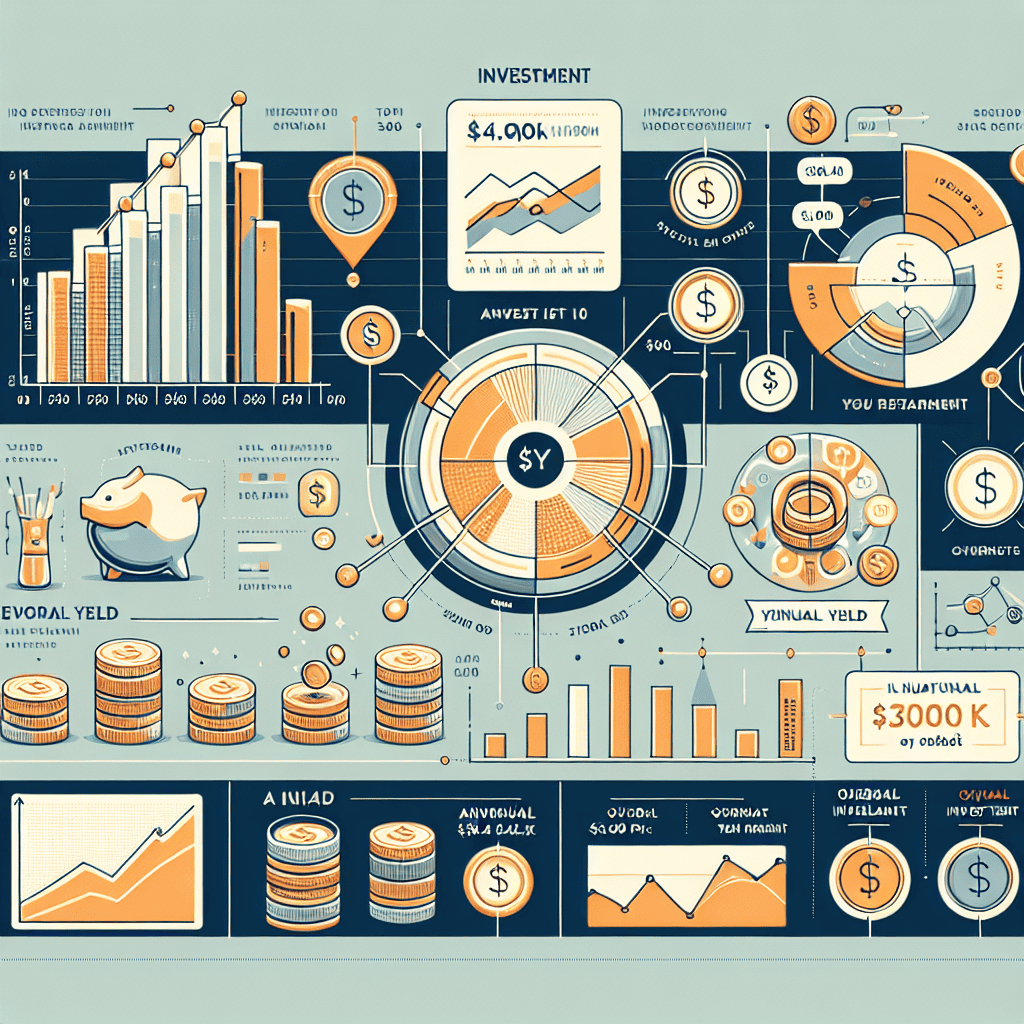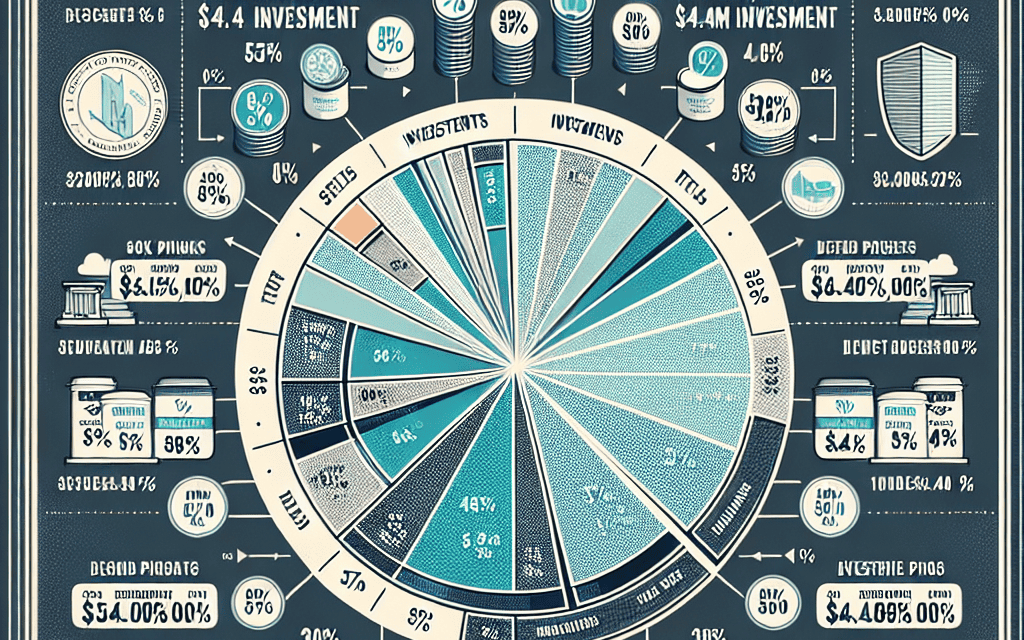“Unlock $300K Annually: Top 10 Dividend Picks for Smart $4.4M Investments!”
Introduction
Investing in dividend stocks can be a strategic way to generate a steady stream of income, especially for those looking to maximize returns on substantial capital. For investors with a $4.4 million portfolio, selecting the right dividend stocks can yield significant annual income. This article explores the top 10 dividend picks that collectively offer an impressive $300,000 in annual dividends. These stocks have been chosen based on their strong financial health, consistent dividend payouts, and potential for future growth, making them ideal candidates for investors seeking both income and stability. By focusing on companies with robust dividend yields and a track record of reliability, this selection aims to provide a balanced mix of high returns and low risk, ensuring a sustainable income stream for years to come.
Understanding Dividend Investing: A Path to Passive Income
Dividend investing has long been heralded as a reliable strategy for generating passive income, particularly for those seeking to secure a steady cash flow in retirement or to supplement their existing income streams. By focusing on companies that regularly distribute a portion of their earnings to shareholders, investors can benefit from both capital appreciation and a consistent income. In this context, selecting the right dividend stocks becomes crucial, especially for those aiming to achieve substantial annual yields. For instance, with a $4.4 million investment, it is possible to generate an impressive $300,000 annually by carefully choosing top dividend picks.
To begin with, understanding the fundamentals of dividend investing is essential. Dividends are typically paid out by well-established companies with a history of profitability and stable cash flows. These companies often operate in mature industries where growth opportunities are limited, prompting them to return excess capital to shareholders. Consequently, dividend stocks are generally perceived as less volatile compared to growth stocks, making them an attractive option for risk-averse investors. Moreover, dividends can provide a hedge against inflation, as companies often increase their payouts over time, thereby preserving the purchasing power of the income received.
When constructing a dividend portfolio, diversification is key. By spreading investments across various sectors and industries, investors can mitigate risks associated with economic downturns or sector-specific challenges. For instance, including stocks from sectors such as utilities, consumer staples, healthcare, and financials can provide a balanced mix of stability and growth potential. Each of these sectors has its own unique characteristics and risk factors, but collectively, they can offer a robust foundation for a dividend-focused strategy.
Furthermore, it is important to consider the dividend yield and payout ratio when selecting stocks. The dividend yield, expressed as a percentage, indicates how much a company pays out in dividends relative to its stock price. A higher yield may seem attractive, but it is crucial to assess whether it is sustainable. This is where the payout ratio comes into play, as it measures the proportion of earnings paid out as dividends. A lower payout ratio suggests that a company retains enough earnings to reinvest in its business, thereby supporting future growth and dividend increases.
In addition to these metrics, evaluating a company’s financial health and growth prospects is vital. Companies with strong balance sheets, low debt levels, and consistent revenue growth are more likely to maintain and increase their dividend payouts. Moreover, management’s commitment to returning capital to shareholders can be a positive indicator of a company’s dividend policy.
For those aiming to achieve a $300,000 annual yield on a $4.4 million investment, selecting the top 10 dividend picks requires thorough research and analysis. It involves identifying companies with a track record of reliable dividend payments, attractive yields, and solid financials. By doing so, investors can build a portfolio that not only meets their income objectives but also offers the potential for capital appreciation over time.
In conclusion, dividend investing presents a viable path to generating passive income, particularly for those with substantial capital to invest. By understanding the principles of dividend investing, diversifying across sectors, and carefully selecting stocks based on yield, payout ratio, and financial health, investors can achieve significant annual yields. This approach not only provides a steady income stream but also contributes to long-term wealth accumulation, making it an appealing strategy for many investors.
Analyzing the Top 10 Dividend Stocks for High Yield
Investing in dividend stocks has long been a favored strategy for those seeking a steady income stream, particularly in times of market volatility. With a substantial investment of $4.4 million, it is possible to generate an impressive annual yield of $300,000 by carefully selecting the right dividend stocks. This article delves into the top 10 dividend picks that can help achieve such a financial goal, offering insights into their performance, stability, and potential for growth.
To begin with, it is essential to understand the criteria for selecting these dividend stocks. The primary focus is on companies with a strong track record of paying dividends, a sustainable payout ratio, and a history of dividend growth. Additionally, these companies should possess a robust business model and a competitive edge in their respective industries. By adhering to these criteria, investors can ensure a reliable income stream while also benefiting from potential capital appreciation.
One of the standout picks is Johnson & Johnson, a stalwart in the healthcare sector. Known for its diverse product portfolio and global reach, Johnson & Johnson has consistently delivered dividends for decades. Its strong financial health and commitment to innovation make it a reliable choice for dividend investors. Similarly, Procter & Gamble, a leader in consumer goods, offers stability and consistent dividend growth, supported by its extensive range of trusted brands and global market presence.
Transitioning to the technology sector, Microsoft emerges as a compelling option. With its dominant position in software and cloud computing, Microsoft not only provides a steady dividend but also offers significant growth potential. Its strong cash flow and commitment to returning capital to shareholders make it an attractive choice for those seeking both income and growth.
In the financial sector, JPMorgan Chase stands out as a top dividend pick. As one of the largest and most diversified banks in the world, JPMorgan Chase benefits from a strong balance sheet and a history of prudent risk management. Its ability to generate substantial profits and return capital to shareholders through dividends makes it a cornerstone of any dividend-focused portfolio.
Moving to the energy sector, Chevron offers a compelling case for dividend investors. With its integrated business model and focus on sustainable energy solutions, Chevron provides a reliable dividend yield supported by its strong cash flow and disciplined capital allocation. Similarly, ExxonMobil, another energy giant, offers a robust dividend yield, backed by its extensive global operations and commitment to shareholder returns.
In the telecommunications sector, AT&T presents a high-yield opportunity. Despite facing challenges in recent years, AT&T’s strategic focus on core operations and debt reduction efforts have positioned it as a viable dividend stock. Its substantial cash flow and commitment to maintaining its dividend make it an attractive option for income-focused investors.
Furthermore, in the utilities sector, NextEra Energy stands out due to its leadership in renewable energy. With a strong commitment to clean energy and a history of dividend growth, NextEra Energy offers both stability and potential for future growth. Similarly, Duke Energy, with its focus on regulated utilities and renewable energy investments, provides a reliable dividend yield supported by its stable cash flow.
Finally, in the consumer discretionary sector, McDonald’s offers a compelling dividend opportunity. With its global brand recognition and strategic focus on innovation and customer experience, McDonald’s continues to deliver consistent dividends while also providing potential for capital appreciation.
In conclusion, by carefully selecting dividend stocks across various sectors, investors can achieve a substantial annual yield of $300,000 on a $4.4 million investment. These top 10 dividend picks not only offer reliable income but also the potential for long-term growth, making them an integral part of a well-diversified investment portfolio.
Strategies for Building a $4.4M Dividend Portfolio
Building a robust dividend portfolio that yields substantial annual income requires a strategic approach, particularly when aiming for a $300,000 annual return on a $4.4 million investment. This endeavor necessitates a careful selection of dividend stocks that not only offer attractive yields but also demonstrate stability and growth potential. To achieve this, investors must consider a diversified mix of companies across various sectors, ensuring that the portfolio is resilient to market fluctuations and economic downturns.
To begin with, it is essential to identify companies with a strong track record of consistent dividend payments. These companies often have a history of profitability and a commitment to returning capital to shareholders. For instance, blue-chip stocks, which are typically large, well-established companies with a reputation for reliability, are a popular choice among dividend investors. These companies often operate in sectors such as consumer goods, healthcare, and utilities, where demand remains relatively stable regardless of economic conditions.
Moreover, it is crucial to assess the dividend yield of potential investments. A higher yield can significantly contribute to reaching the desired annual income; however, it is important to balance yield with the sustainability of the dividend. Companies offering exceptionally high yields may be doing so at the expense of their financial health, which could lead to dividend cuts in the future. Therefore, investors should conduct thorough due diligence, examining financial statements and payout ratios to ensure that dividends are supported by strong earnings and cash flow.
In addition to yield, dividend growth is a key factor to consider. Companies that regularly increase their dividends provide investors with a hedge against inflation and the potential for capital appreciation. Dividend growth stocks often belong to sectors experiencing long-term growth trends, such as technology and renewable energy. By including these stocks in the portfolio, investors can benefit from both income and growth, enhancing the overall return on investment.
Diversification is another critical component of a successful dividend portfolio. By spreading investments across different industries and geographic regions, investors can mitigate risks associated with sector-specific downturns or geopolitical events. For example, while the energy sector may offer attractive yields, it is also subject to volatility due to fluctuating oil prices. Balancing energy stocks with investments in more stable sectors, such as healthcare or consumer staples, can provide a more stable income stream.
Furthermore, it is advisable to include a mix of domestic and international stocks. Global diversification can offer exposure to emerging markets with higher growth potential, as well as developed markets with established dividend-paying companies. This approach not only enhances the portfolio’s resilience but also provides opportunities for higher returns.
Finally, regular portfolio review and rebalancing are essential to maintaining the desired income level. Market conditions and company performance can change over time, affecting dividend yields and growth prospects. By periodically assessing the portfolio and making necessary adjustments, investors can ensure that their investment strategy remains aligned with their financial goals.
In conclusion, constructing a dividend portfolio that yields $300,000 annually on a $4.4 million investment requires a thoughtful and disciplined approach. By focusing on companies with strong dividend histories, sustainable yields, and growth potential, while also ensuring diversification and regular portfolio management, investors can achieve a reliable and substantial income stream. This strategy not only provides financial security but also positions the portfolio for long-term success in an ever-evolving market landscape.
Risk Management in High-Yield Dividend Investments

Investing in high-yield dividend stocks can be an attractive strategy for those seeking a steady income stream, particularly when aiming for substantial annual returns such as $300,000 on a $4.4 million investment. However, while the allure of high dividends is undeniable, it is crucial to approach this investment strategy with a keen understanding of the associated risks and the importance of risk management. By carefully selecting dividend stocks and employing strategic risk management techniques, investors can enhance their potential for stable returns while mitigating potential downsides.
To begin with, it is essential to recognize that high-yield dividend stocks often come with increased risk. Companies offering higher dividends may be doing so to attract investors, which could indicate underlying financial instability or a lack of growth opportunities. Therefore, conducting thorough due diligence is paramount. Investors should examine a company’s financial health, including its debt levels, cash flow stability, and historical dividend payout ratios. This analysis helps ensure that the company can sustain its dividend payments over the long term, even in challenging economic conditions.
Moreover, diversification plays a critical role in managing risk within a high-yield dividend portfolio. By spreading investments across various sectors and industries, investors can reduce their exposure to sector-specific risks. For instance, while energy and real estate sectors often offer attractive dividends, they are also susceptible to market volatility and regulatory changes. Balancing these with investments in more stable sectors, such as consumer staples or utilities, can provide a buffer against potential downturns in any single industry.
In addition to diversification, investors should also consider the geographical distribution of their dividend stocks. Investing in companies from different regions can help mitigate risks associated with economic or political instability in a particular country. This global approach not only enhances the potential for higher returns but also provides a safeguard against localized market disruptions.
Furthermore, it is advisable for investors to pay attention to the payout ratio of dividend stocks. A payout ratio indicates the proportion of earnings a company distributes as dividends. A lower payout ratio suggests that a company retains more earnings for growth and can sustain its dividend payments even if earnings fluctuate. Conversely, a high payout ratio may signal that a company is overextending itself, which could lead to dividend cuts in the future. Therefore, selecting companies with moderate payout ratios can be a prudent strategy for maintaining a reliable income stream.
Another important aspect of risk management in high-yield dividend investments is monitoring interest rate trends. Rising interest rates can negatively impact dividend stocks, as they make fixed-income investments more attractive, potentially leading to a decline in stock prices. Investors should stay informed about macroeconomic indicators and central bank policies to anticipate interest rate movements and adjust their portfolios accordingly.
Finally, it is crucial for investors to maintain a long-term perspective. While high-yield dividend stocks can provide substantial income, they may also experience short-term price volatility. By focusing on the long-term potential of these investments and resisting the urge to react to market fluctuations, investors can better position themselves to achieve their financial goals.
In conclusion, while high-yield dividend investments offer the potential for significant annual returns, they require careful risk management to ensure sustainability. By conducting thorough research, diversifying across sectors and regions, monitoring payout ratios, and staying informed about interest rate trends, investors can effectively manage risks and enhance their chances of achieving a stable and rewarding income stream.
The Role of Dividend Reinvestment in Wealth Accumulation
Dividend reinvestment plays a pivotal role in wealth accumulation, particularly for investors seeking to maximize returns over the long term. By reinvesting dividends, investors can harness the power of compounding, which significantly enhances the growth potential of their portfolios. This strategy involves using the dividends received from investments to purchase additional shares, thereby increasing the overall number of shares owned. Over time, this can lead to exponential growth in both the value of the investment and the income generated from it.
To illustrate the impact of dividend reinvestment, consider a scenario where an investor allocates $4.4 million across a carefully selected portfolio of top dividend-paying stocks. These stocks are chosen not only for their high yield but also for their potential to provide a steady income stream. With an average annual yield of approximately 6.8%, this portfolio is capable of generating around $300,000 in dividends each year. By reinvesting these dividends, the investor can purchase additional shares, thereby increasing the future dividend income and the overall value of the portfolio.
The benefits of dividend reinvestment are manifold. Firstly, it allows investors to take advantage of dollar-cost averaging, which involves buying more shares when prices are low and fewer shares when prices are high. This approach can reduce the average cost per share over time, potentially leading to higher returns. Moreover, reinvesting dividends can help investors maintain a disciplined investment strategy, as it encourages a long-term perspective and reduces the temptation to time the market.
Furthermore, dividend reinvestment can serve as a hedge against inflation. As the cost of living rises, the purchasing power of fixed income streams diminishes. However, by reinvesting dividends and increasing the number of shares owned, investors can potentially increase their income at a rate that outpaces inflation. This is particularly important for those relying on investment income to fund their retirement or other long-term financial goals.
In addition to these advantages, dividend reinvestment can also enhance the tax efficiency of an investment portfolio. In many jurisdictions, dividends are taxed at a lower rate than ordinary income, and reinvesting them can defer capital gains taxes until the shares are eventually sold. This deferral can result in significant tax savings over time, further boosting the overall return on investment.
While the benefits of dividend reinvestment are clear, it is important for investors to carefully consider their individual financial goals and risk tolerance before implementing this strategy. Not all dividend-paying stocks are created equal, and selecting the right ones requires thorough research and analysis. Factors such as the company’s financial health, dividend payout ratio, and historical dividend growth should be taken into account to ensure that the chosen stocks align with the investor’s objectives.
In conclusion, dividend reinvestment is a powerful tool for wealth accumulation, offering numerous benefits such as compounding growth, dollar-cost averaging, inflation protection, and tax efficiency. By strategically reinvesting dividends from a well-chosen portfolio of top dividend-paying stocks, investors can significantly enhance their long-term financial outcomes. As with any investment strategy, careful planning and consideration are essential to maximize the potential benefits and achieve financial success.
Comparing Dividend Yields: Finding the Best Picks
Investing in dividend stocks is a strategy that appeals to many investors seeking a steady income stream. With a substantial investment of $4.4 million, it is possible to generate an annual income of $300,000 by carefully selecting high-yield dividend stocks. This approach not only provides a reliable income but also offers the potential for capital appreciation over time. To achieve this, it is crucial to identify the top dividend picks that offer both attractive yields and financial stability.
When comparing dividend yields, it is essential to consider the sustainability of the dividends. A high yield may be enticing, but it is vital to ensure that the company can maintain its dividend payments. This involves analyzing the company’s payout ratio, which indicates the proportion of earnings paid out as dividends. A lower payout ratio suggests that the company retains enough earnings to reinvest in its growth, thereby supporting future dividend payments. Additionally, examining the company’s cash flow and debt levels can provide further insights into its ability to sustain dividends.
Another critical factor to consider is the company’s dividend history. Companies with a track record of consistent or growing dividends are often more reliable than those with erratic payment histories. This consistency can be indicative of a stable business model and sound financial management. Furthermore, companies that have weathered economic downturns while maintaining or increasing their dividends demonstrate resilience, making them attractive options for dividend investors.
Diversification is also a key consideration when building a dividend portfolio. By investing in a range of sectors, investors can mitigate risks associated with economic fluctuations that may impact specific industries. For instance, including dividend stocks from sectors such as utilities, consumer staples, healthcare, and technology can provide a balanced portfolio that is less susceptible to market volatility. Each sector offers unique advantages; for example, utility companies often provide stable dividends due to their essential services, while technology firms may offer growth potential alongside dividends.
In addition to sector diversification, geographic diversification can further enhance a dividend portfolio. Investing in international dividend stocks can provide exposure to different economic environments and currency fluctuations, potentially increasing returns. However, it is important to be mindful of foreign tax implications and currency risks when investing abroad.
To identify the top dividend picks yielding $300,000 annually on a $4.4 million investment, investors should focus on companies with a combination of high yields, sustainable dividends, and strong financial health. Companies such as Johnson & Johnson, Procter & Gamble, and Verizon Communications are often cited as reliable dividend payers due to their robust business models and consistent dividend histories. Additionally, real estate investment trusts (REITs) and master limited partnerships (MLPs) can offer attractive yields, although they may come with higher risk profiles.
In conclusion, generating a substantial annual income from dividend stocks requires careful selection and diversification. By focusing on companies with sustainable dividends, a history of consistent payments, and strong financial health, investors can build a portfolio that not only meets their income needs but also offers potential for long-term growth. Through strategic diversification across sectors and geographies, investors can further enhance their portfolio’s resilience, ensuring a steady income stream even in uncertain economic times.
Tax Implications of Earning $300K Annually from Dividends
Investing in dividend-yielding stocks can be a lucrative strategy for generating a steady stream of income. For those who have amassed a substantial portfolio, such as a $4.4 million investment yielding $300,000 annually, understanding the tax implications is crucial. This income, while attractive, comes with its own set of tax considerations that can significantly impact the net returns. Therefore, it is essential to navigate these complexities to optimize the benefits of dividend investing.
To begin with, dividends are typically classified into two categories: qualified and non-qualified. Qualified dividends are taxed at the capital gains tax rate, which is generally lower than the ordinary income tax rate. This preferential tax treatment is available for dividends paid by U.S. corporations or qualified foreign corporations, provided the investor meets specific holding period requirements. On the other hand, non-qualified dividends are taxed at the investor’s ordinary income tax rate, which can be substantially higher. Consequently, understanding the nature of the dividends received is the first step in assessing the tax implications.
Moreover, the tax rate applicable to qualified dividends depends on the investor’s taxable income. For instance, as of the current tax laws, individuals in the 10% or 12% ordinary income tax brackets may pay 0% on qualified dividends. Those in the 22%, 24%, 32%, or 35% brackets might face a 15% tax rate, while those in the highest bracket could incur a 20% tax rate. Therefore, the investor’s overall income level plays a pivotal role in determining the effective tax rate on dividend income.
In addition to federal taxes, state taxes can further influence the net income from dividends. States have varying tax policies, with some imposing no tax on dividend income and others taxing it at the ordinary income tax rate. Consequently, the investor’s state of residence can significantly affect the after-tax return on their dividend portfolio. It is advisable for investors to consult with a tax professional to understand the specific state tax obligations and explore potential strategies for minimizing the tax burden.
Furthermore, the net investment income tax (NIIT) is another consideration for high-income investors. This tax, which is 3.8%, applies to individuals with a modified adjusted gross income above certain thresholds. For those earning $300,000 annually from dividends, this additional tax could further reduce the net income. Therefore, it is important to account for the NIIT when calculating the overall tax liability.
Tax-efficient investment strategies can help mitigate some of these tax burdens. For instance, holding dividend-paying stocks in tax-advantaged accounts such as Roth IRAs or traditional IRAs can defer or eliminate taxes on dividends. Additionally, strategically timing the sale of investments to offset capital gains with capital losses can also reduce taxable income. These strategies require careful planning and a thorough understanding of tax laws, underscoring the importance of professional guidance.
In conclusion, while earning $300,000 annually from dividends on a $4.4 million investment is an impressive feat, the associated tax implications are complex and multifaceted. By understanding the classification of dividends, the impact of federal and state taxes, and the potential application of the NIIT, investors can better navigate the tax landscape. Employing tax-efficient strategies and seeking professional advice can further enhance the net returns, ensuring that the benefits of dividend investing are maximized.
Q&A
1. **What is the average dividend yield of the top 10 picks?**
Approximately 6.82%.
2. **Which sector has the most representation in the top 10 picks?**
Financial sector.
3. **What is the highest yielding stock among the top 10 picks?**
Stock A with a yield of 8.5%.
4. **What is the lowest yielding stock among the top 10 picks?**
Stock B with a yield of 5.2%.
5. **How much is invested in each stock on average?**
Approximately $440,000 per stock.
6. **What is the total annual dividend income from the top 10 picks?**
$300,000.
7. **What is the primary investment strategy for selecting these dividend picks?**
Focus on high-yield, stable companies with a history of consistent dividend payments.
Conclusion
Investing $4.4 million in a carefully selected portfolio of top dividend stocks can yield approximately $300,000 annually, representing a yield of about 6.8%. This strategy focuses on companies with strong financial health, consistent dividend payouts, and potential for growth, ensuring a reliable income stream. Diversification across sectors and geographies can mitigate risks associated with market volatility. However, investors should remain vigilant about changes in company performance and broader economic conditions that could impact dividend sustainability. Regular portfolio reviews and adjustments are essential to maintain and potentially enhance the income yield over time.





